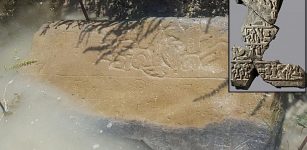Rock Stars: How A Group Of Scientists In South Africa Rescued A Rare 500 Kg Chunk Of Human History
AncientPages.com - Scientific breakthroughs can happen in the strangest ways and places. Alexander Fleming discovered penicillin because of mold growing on a Petri dish left out while he was on holiday. Chinese monks in the 9th century wanted to make a potion for immortality: instead, they discovered gunpowder.
Our own remarkable discovery happened on a rugged, remote stretch of coastline east of Still Bay on South Africa's Cape south coast. It was low tide, and three members of our ichnology team (people who study tracks and traces) were in search of newly exposed Pleistocene vertebrate tracksites in aeolianites (cemented dunes).
The larger of the two triangular geometric features (scale bar = 10 cm). Credit: Charles Helm
Ahead we saw a large rock that had tumbled down from the cliffs above. On its surface was a pattern of linear groove features in a large triangular shape, complete with an almost perfect bisecting groove. The sides of the triangle were close to a meter in length. After extensive research, we concluded that these grooves must have been made on a dune surface of unconsolidated sand by our human ancestors in the Middle Stone Age. The patterns are likely between 143,000 and 91,000 years old.
It was an important find in a significant place. Multiple lines of evidence on this coastline indicate that it's an area where our distant ancestors became truly modern, using fire as an engineering tool and creating abstract images.
But there was a problem. On a followup visit we found a smaller rock close by with a similar triangular feature. Subsequently, it was destroyed, likely by storm surges or high tides buffeting and overturning it. We knew that the larger rock inevitably awaited a similar fate if we did nothing. From our perspective this is one of the most important rocks in the world: it takes us back to our roots as a species and indicates the kind of "proto-art" we were capable of creating so long ago.
An unusual ‘rescue operation’ captured on video by Richard Webb.
The rock has subsequently been encased and placed on exhibit, with interpretive text panels. It joins similar exhibits in the museum; the grooves were an example of an ammoglyph, a term we had coined to describe a pattern created by humans in sand that is now evident in rock that has become cemented and then re-exposed.
Ascribing meaning to these geometric patterns made so long ago by our distant ancestors is not within our field of expertise. Still, we could not help but notice the resemblance of the triangular shape to a purported fertility symbol found in France and dated to around 38,000 years. Should the pattern on our rock represent the same motif, it would not be the first time that southern African discoveries had pushed back in time what has been viewed as an Upper Paleolithic Eurasian phenomenon.
A helicopter, net and a long-line cable - as well as a skilled pilot - were key to the ‘rescue’ operation. Credit: Richard Webb
Our research team now sleeps better at night, knowing that this priceless piece of our human heritage has been recovered and is available for others to see, appreciate and critique.
More to discover
Happily, there was an unexpected bonus. Beside the eroded remains of the second rock our ground crew noted a third rock surface which had not been evident previously. Near one edge it contained a distinct pair of grooves that met at an angle of 69 degrees, forming what may have been part of another triangular feature.
This is clearly an area we will return to repeatedly, in the hope that tidal forces may turn over other rocks before destroying them, and may give us an opportunity to glimpse—and perhaps recover—more ammoglyphs.
Written by Charles Helm, Research Associate, African Centre for Coastal Palaeoscience, Nelson Mandela University
and Jan Carlo De Vynck, Director and research fellow, African Centre for Coastal Palaeoscience, Nelson Mandela University, Nelson Mandela University
This article is republished from The Conversation under a Creative Commons license. Read the original article.
More From Ancient Pages
-
 Scottish Settler’s Ominous Encounter With A Mysterious Being In West Virginia
Featured Stories | Mar 18, 2024
Scottish Settler’s Ominous Encounter With A Mysterious Being In West Virginia
Featured Stories | Mar 18, 2024 -
 Statue Of Gudea: The King-Priest Of Sumerian City Of Lagash In Southeast Mesopotamia
Featured Stories | Aug 14, 2016
Statue Of Gudea: The King-Priest Of Sumerian City Of Lagash In Southeast Mesopotamia
Featured Stories | Aug 14, 2016 -
 How Is DNA Preserved In Archaeological Sediments For Thousands Of Years
Archaeology | Jan 3, 2022
How Is DNA Preserved In Archaeological Sediments For Thousands Of Years
Archaeology | Jan 3, 2022 -
 ‘Masters Of The Desert’ – Hohokam People, Massive Caliche Structures And Sophisticated Extensive Irrigation Canals
Civilizations | May 31, 2016
‘Masters Of The Desert’ – Hohokam People, Massive Caliche Structures And Sophisticated Extensive Irrigation Canals
Civilizations | May 31, 2016 -
 Why Is Caganer, The Pooping Man Part Of The Catalonian Christmas Tradition And Nativity Scene?
Christmas Traditions | Dec 18, 2024
Why Is Caganer, The Pooping Man Part Of The Catalonian Christmas Tradition And Nativity Scene?
Christmas Traditions | Dec 18, 2024 -
 3D Scans Used To Study Mysterious Roman Burial Practice
Archaeology | Jun 5, 2023
3D Scans Used To Study Mysterious Roman Burial Practice
Archaeology | Jun 5, 2023 -
 10 Magnificent Ancient Libraries
Featured Stories | Feb 6, 2016
10 Magnificent Ancient Libraries
Featured Stories | Feb 6, 2016 -
 Makara – Legendary Sea-Creature With Many Incarnations In Hindu Mythology
Ancient Symbols | Feb 2, 2020
Makara – Legendary Sea-Creature With Many Incarnations In Hindu Mythology
Ancient Symbols | Feb 2, 2020 -
 Colossi Of Memnon Guarded Temple Of Pharaoh Amenhotep III And Curious Sound Phenomenon
Featured Stories | Feb 2, 2021
Colossi Of Memnon Guarded Temple Of Pharaoh Amenhotep III And Curious Sound Phenomenon
Featured Stories | Feb 2, 2021 -
 Traces Of Early Humans Discovered In Southern Iran
Archaeology | Sep 25, 2019
Traces Of Early Humans Discovered In Southern Iran
Archaeology | Sep 25, 2019 -
 Selah – Mysterious Biblical Word Of Unknown Meaning
Biblical Mysteries | Jan 5, 2018
Selah – Mysterious Biblical Word Of Unknown Meaning
Biblical Mysteries | Jan 5, 2018 -
 Forbidden Ancient Manuscripts Almost Erased From History – Secret Teachings Of Mysterious Founder – Part 1
Ancient Mysteries | May 10, 2018
Forbidden Ancient Manuscripts Almost Erased From History – Secret Teachings Of Mysterious Founder – Part 1
Ancient Mysteries | May 10, 2018 -
 Kap Dwa – Mysterious Two-Headed Mummified Patagonian Giant – Real Or Fake?
Featured Stories | May 20, 2021
Kap Dwa – Mysterious Two-Headed Mummified Patagonian Giant – Real Or Fake?
Featured Stories | May 20, 2021 -
 Lost City That May Have Defeated King Midas’ Kingdom Phrygia – Found Accidentally
Archaeology | Feb 23, 2020
Lost City That May Have Defeated King Midas’ Kingdom Phrygia – Found Accidentally
Archaeology | Feb 23, 2020 -
 Controversial Evidence – Ancient Chinese Visited America 2,500 Years Ago
Civilizations | May 9, 2015
Controversial Evidence – Ancient Chinese Visited America 2,500 Years Ago
Civilizations | May 9, 2015 -
 Unkulunkulu: ‘Great Oldest One’ Progenitor Of Mankind, Creator Of All Things And Origin Of Death In Beliefs Of Zulu People
African Mythology | Sep 30, 2019
Unkulunkulu: ‘Great Oldest One’ Progenitor Of Mankind, Creator Of All Things And Origin Of Death In Beliefs Of Zulu People
African Mythology | Sep 30, 2019 -
 Perfectly Preserved 10,500-Year-Old Basket Found In Muraba’at Cave
Archaeology | Mar 18, 2021
Perfectly Preserved 10,500-Year-Old Basket Found In Muraba’at Cave
Archaeology | Mar 18, 2021 -
 Mysterious Bronze Age Viksö Helmets With Horns Related To Myths, Holy Animals And Divine Power
Artifacts | Feb 27, 2018
Mysterious Bronze Age Viksö Helmets With Horns Related To Myths, Holy Animals And Divine Power
Artifacts | Feb 27, 2018 -
 On This Day In History: 150 Highly-Trained Swiss Guards Entered Vatican For The First Time – On Jan 22, 1506
News | Jan 22, 2017
On This Day In History: 150 Highly-Trained Swiss Guards Entered Vatican For The First Time – On Jan 22, 1506
News | Jan 22, 2017 -
 The Unicorn In The Bible Was An Oryx – Ancient Translation Mistake
Ancient History Facts | Apr 24, 2018
The Unicorn In The Bible Was An Oryx – Ancient Translation Mistake
Ancient History Facts | Apr 24, 2018


